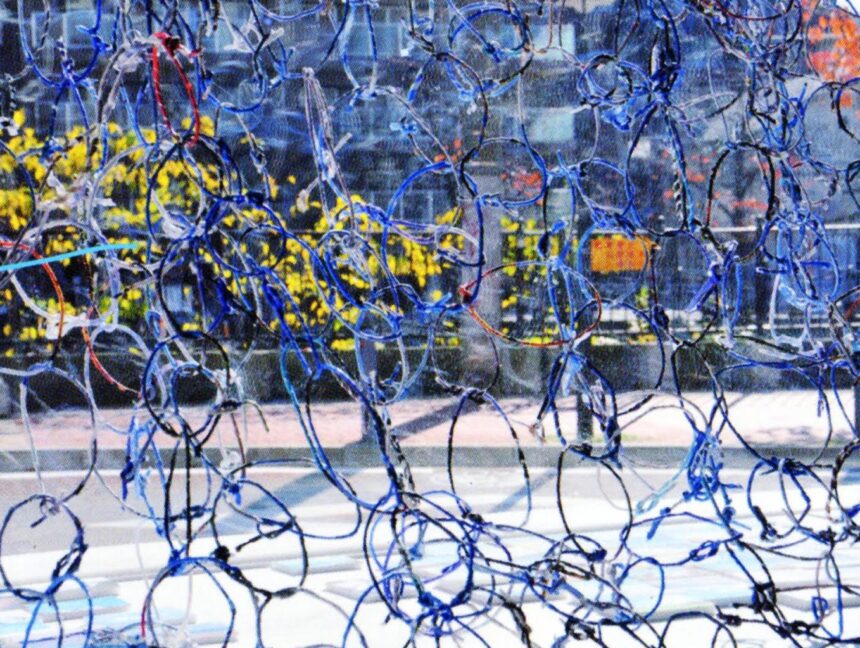Japan’s Social Turn: Introduction to Part II
Justin Jesty
A note on names: The first mention of a Japanese person’s name in each article in this issue of FIELD is written with their last name in all caps to allow readers to distinguish first and last names. Japanese names sometimes appear with the family name first (the default in Japanese and in academic writing in English), but also sometimes appear with the first name first (the default for people born in or longtime residents of Europe or the U.S., and for journalism in English).
My introduction to the second part of “Japan’s Social Turn” is shorter than the previous one. It will stick to the task of providing contextual information relevant to the five essays in this issue—three around the theme “Policy and Practice” and two that focus on the ongoing work of active/activist artists, which I have grouped under the heading “Vernacular Designs.” For a more comprehensive introduction to socially engaged art and new public art in Japan, please refer to my essay “Japan’s Social Turn: An Introductory Companion” in the previous issue.
The essays grouped as “Policies and Practice” are an essential part of the whole collection. Assessing socially engaged art and new public art requires some awareness of policy and institutions, not only because these new practices take form in a partial rejection of existing social framings for art and artists’ work but more importantly because they are constitutively interested in making art’s social functions and supports more consistently manifest. If an artist rejects the gilded cage of the art system, what are they rejecting? But also, how does that process of rejection shape the form of their overcoming? What is it that the artist can do better outside the art system? But also, what new system(s) do they encounter in that outside? Where/when is artwork allowed or not allowed, attended or unattended? How will the artist eat, find shelter, and otherwise live life? Answers to these questions vary greatly from place to place. As many have noted when moving between the U.S. and the E.U., translation errors often occur.
KAWASHIMA Nobuko provides an invaluable introduction to shifts in art’s infrastructure in Japan since the 1990s, focusing on changes that have likely favored the development of art projects. Many of the issues have parallels in the U.S. and Britain: the grant game and NPO network that have developed to fund art projects will probably feel familiar to many readers. The way that current policy discourse justifies arts spending by claiming that it has a positive impact on the economy, education, welfare, and the like, is something Japan has in common with many other developed countries. Kawashima notes that there is a “universally weak justification for cultural policy for the sake of arts and culture in and of themselves.” Readers will be able to detect the discourse of neoliberalism in the push for greater local autonomy and accountability, and in the way that “collaborative,” “self-directed” and “creative,” have become key terms for new forms of governmentality. Although not a major part of Kawashima’s account, neoliberalism has also affected public museums in Japan, subjecting them to a semi-private “designated manager system (shitei kanrisha seido)” with the aim of greater efficiency.
There are also major differences that may alter our assessment of these otherwise similar trends. First, from the perspective of artists and would-be curators/arts managers it is not clear whether the present situation is worse than before in terms of the availability of support for one’s work. Reiko Tomii’s paper in FIELD 7 argues that contemporary artists in Japan faced a social support system for contemporary art that was much less powerful—as something to rely on or to contend with—than in the U.S. or Europe. The market for contemporary art by Japanese artists was extremely weak in Japan until the 1980s. Many contemporary artists saw going abroad as the best way to pursue their career. On the whole, museums were also uninterested in supporting emerging artists. As Kawashima’s analysis shows, the lion’s share of public spending on arts and culture until the late 1990s went towards preservation of cultural heritage and building massive new facilities. This had little benefit for most Japanese contemporary artists or audiences. One might suspect that the shift in policy emphasis towards programming is simply a form of cost-saving. Art projects are much cheaper than buildings. But one effect of the shift has been a proliferation of exhibition opportunities for young Japanese artists and a rise in the status of the arts manager as an expert rather than a generic public official. Second, the fact that people producing cultural programs are expected to have a relationship with surrounding communities is a trend that some might take to threaten art’s autonomy in the name of popularity. But against the background of the sometimes spectacular waste of public funds for large buildings with little purpose, it is difficult not to see this as an improvement. Finally, as I mentioned in my introduction to FIELD 7, neoliberalism is not the only key to recent institutional shifts in Japan. Degrowth is at least as important and is likely to become more important in future.
Degrowth is a major concern, especially for rural areas and regional towns and cities. It is in those settings that revitalization has become particularly important for art projects. Revitalization, regeneration and redevelopment are the goals most often invoked to claim a direct social or public value for art and art projects. YOSHIMOTO Mitsuhiro’s article provides insight into the way art works in that setting, using the case of Kamiyama Town. Kamiyama has become an internationally recognized model for regional regeneration. For that reason, it is extremely useful in showing how the value of contemporary art and cultural investment is conceived in this area of public concern.
Before going further, it is important to address revitalization in and of itself. It needs to be translated carefully. Although revitalization is the accepted key term in both Japanese and English, it may be a misnomer. The editors of an important study of Japan’s regional degrowth write, “One question raised by our research is whether revitalization—to the extent that it means a return to growth—is ultimately possible within the context of the protracted depopulation that Japan has only just begun to experience. We therefore invite readers to consider other concepts, such as stability and sustainability as replacements.”[1] Kamiyama resident ŌMINAMI Shinya, who figures prominently in Yoshimoto’s account, makes a similar point with his idea of “creative depopulation.” Ōminami assumes that population decline cannot be reversed in real terms.
Sustainability in this context is not conceived as a question of ensuring continuing capacity for biological life. Japan has national health insurance and high quality public education, it continues to pay pensions and social welfare, and there is excellent transport and communications infrastructure even in remote areas. The basic supports for individual life that developed societies (except the U.S.) usually expect of the state are there, and are not being rewritten to be conditional upon citizens demonstrating their creativity. It is also not a question of species survival: although many art projects do explore sustainability as an ecological question, the main focus of revitalization discourse is sustainability at the level of the discrete collective. Villages are dying. Regions are dying. Ways of life are dying.
Strict liberal logic might say that they should die if the market does not support them. From a central planning or welfare-state perspective as well, the dispersal of the most needy population across the most difficult terrain is inefficient. These dying regions are therefore surviving for the time being against the logics of profit maximization and efficiency. In that sense there is a parallel between them and urban neighborhoods that face the threat of redevelopment. The arguments lodged against such neighborhoods is that they are not contributing as much to the city as an office park or a high-rise apartment building would. The challenge facing Japan’s regions is similar: how to survive collectively in a world where the larger economic forces welcome their extinction. But there are two important differences. One is that Japan’s rural areas are not further marginalized by racism and class discrimination in any patterned way, as is often the case for targets of redevelopment in the U.S. and Europe. The other is that the destruction they face will not come in the form of the wrecking ball or rising rents but in gradual decay, as the human life slowly drains from them.
Those differences are important. In Europe and the U.S., critical discourse on gentrification and neo-liberalism assumes antagonism among competing interests, which demands agonistic contestation over who controls the use and culture of certain spaces. These assumptions fit contexts where there is market pressure on space. While Japan’s regional decline may stem from the same market forces, they manifest as negative pressure in those locales. People are pulled (not pushed) away and local cultures are pulled apart. Because the dynamics of the situation are entropic rather than intensive, their general social form is unlikely to manifest as a clash. Further, because of the social standing of residents, revitalization does not become a battlefront in struggles against racism and class discrimination as it does when segregation dominates the political geography. These differences, I think, also make the cultural form of a clash less obviously appropriate. What general cultural form might fit such situations is difficult to articulate using the available discourse of avant-garde art and its politics, because so much of that discourse assumes intensifying urban situations as the setting of its playing out. This may be one reason why generating attraction becomes more important than establishing critical positionality for artists and organizers working for sustainability in rural Japan.
We can see in Yoshimoto’s account of Kamiyama how ideas like the creative city work differently in a depopulating small town. The theory is basically the same: if creative types (meaning people in high value-added, low volume technology and design professions) could be enticed to relocate, it would revitalize Kamiyama by introducing a new economic base and by bringing young people into the population. The overriding goal in Kamiyama, however, is to fix a demographic imbalance. The ultimate target is not money or even investment but young people who will have children. The economy becomes a problem because no one could relocate there without a job, meaning that if young people are going to relocate, they will have to bring their job with them. The scale of the operation is also different. A couple dozen local people spearheaded the initiative and have made it run successfully over the years through their personal commitment. The number of people they hope to attract to Kamiyama is similarly small—about 20 per year. At that scale, the process is highly focused on the individual: each person who relocates receives individual attention while each volunteer with Green Valley has unique qualities and abilities. We can understand why Kamiyama might be attractive for young people disillusioned with the city: it enables a qualitatively different experience of social life. People respond to each other, support each other, show interest in each others’ unique talents, and the communal significance of one’s own actions is quite visible.
A final difference is that Kamiyama is hoping to create flight away from cities rather than the reverse. In doing so, they are not casting around blindly. A significant number of people in Japan in their 20s, 30s and 40s, are turning away from large cities to look for ways to live in the countryside. The phenomenon is called the U-turn when people return to the region where they were born and the I-turn when a person moves to a place they have no prior connection with. Sometimes the move is for work or family, but it is increasingly made as a lifestyle choice.[2] Large cities, especially Tokyo, demand great effort to escape their sprawl and are associated with a low quality of life that can be crowded, impersonal, culturally unremarkable, and that encourages a poor work/life balance. The Green Valley NPO has found a way to tap into this latent demand.
Although some of the objections to revitalization appear not to apply in this situation, there are still concerns. The main one, which stems from the discrimination at the heart of creative city discourse, is access. When Green Valley recruits people to relocate to Kamiyama they explicitly seek those who can support themselves economically and have the capacity to become active in civic life. That would exclude the poor and less educated. The implicit emphasis on families (demographic stabilization ultimately hinges on babies) might also lead to discrimination against same sex couples or the elderly. Although it is a small operation and the elderly and the poor may be unlikely to try to move there anyway, the issue makes their success unscalable. Even on a small scale, if demand for empty houses outstrips supply, the question of access could become urgent. No one is literally being pushed out of Kamiyama, but there is an unspecified potential for people to be excluded before they arrive.
The issue of exclusion is more troublesome in the case of Koganechō, which I write about. In Koganechō the people excluded are the sex workers whose workplaces were suddenly shut down en masse by a concerted police crackdown in 2005. The art project, the Koganechō Bazaar, began three years later and has been intended to build a new identity and new forms of outdoor public life for the area, which had been dominated by organized crime and was long associated with the sex trade. One of the questions that dominates my paper is how to weigh the absence of the sex workers in assessing the Bazaar. Insofar as the project and the artists working within it are taken to be addressing the actual conditions they encounter in Koganechō, it is quite a successful example of new public art. It has run for ten years with a tremendous amount of investment from local residents and from the management and artists. Only when we consider it in relation to absences, to potentials with little substance, do we find grounds to critique it.
Socially engaged art (and most forms of art) require presence, visibility, or audibility for their basic operation. Conversational, collaborative and participatory projects require participants.Ethnographic/oral history projects use subjects’ voice, photographs, artwork or artifacts as material. How can absence appear with equal weight? The fact that Japan accepted only 28 refugees in 2016—and that that is a normal number—should be considered part of the refugee crisis.[3] But how do we figure that absence—the 10,000 or 100,000 or 1,000,000 who didn’t get in or didn’t even apply? A similar question runs though my consideration of the Koganechō Bazaar. Given that what is visible—what appears as actual (as opposed to symbolic or merely representational)—is itself politically implicated, I raise this as a caution against the elevation of the “actual” as a transparent value in socially engaged and new public art.[4] This is especially important in Japan, where so much of politics occurs over the in/visibility of certain questions prior to them becoming visible as such. Starting with the actual risks missing the most important political questions.
I will wrap up with this thought in mind. As may be apparent from this issue and the previous one, art projects tend to dominate discussions of socially engaged and new public art in Japan. The problem with that, in my view, is not to be found in the art projects per se, but in the absence of discussion of other forms of socially engaged art. The two papers grouped under the heading “Vernacular Designs” may help address this problem. They introduce two approaches that are quite distinct from regional revitalization and would never be called art projects in Japanese. The reason that we can call them socially engaged art is that they both engage directly in particular social issues over long periods of time, and both involve collaboration as a generative practice. Neither of the projects is tied to a particular site. However, the infrastructures these artists activate and/or create in the process of production and exhibition are part of their work and its meaning. Recognizable, figurative artworks are central to both, yet account for only one part of a complex of positions, performances, attitudes and inter-personal protocols that mutually shape their ongoing work.
Anne McKnight introduces us to the work of Rokudenashiko, as it has developed in the context of her being arrested multiple times for alleged violation of obscenity laws. The general intent of Rokudenashiko’s work is to demystify the vulva, to bring it out from the shadows of secrecy and stigma and normalize it by making it available for celebration and play. As McKnight shows, Rokudenashiko’s work includes manga, performance, media art, and speculative design. She does not work in standard participatory or collaborative forms. But those might not be well-suited to the problem she is engaged with. As a problem of consciousness and general social norms, the taboo surrounding vulvas needs to be addressed in a mass-reproducible form if it is to become an actual social intervention. Rokudenashiko’s modular aesthetic creates both mass-reproducibility and near-infinite potential for customization and recontextualization. Production is collaborative in that it relies on a network of makers who share technical knowledge and machinery, but more importantly in that her campaign to make the vulva ubiquitous requires participation that is massive yet personalized. Cuteness invites those dynamics. McKnight’s research also reveals how Rokudenashiko made her appearance in the media part of her work by cultivating a “cute” media persona that would further the goals of her intervention while short-circuiting the stereotype of the bitter activist or joyless feminist. The infectivity of cuteness in both her persona and her modular designs tempt the audience to collaborate in her project by joining in the fun.
As KANŌ Ai shows, the woodblock print collective A3BC also invests various facets of its practice with meaning. While woodblock prints provide a medium for collectivity, the meaning of their collective work is as much to be found in the time spent together as in the prints themselves. The relationships they cultivate with collectives in Southeast Asia and Europe are similarly valuable: the shared practice of printing is just one medium of that connection. Although it is a comparison neither party would likely recognize, the interest in finding a better quality of life in a spirit of generosity and mutual aid is common to the vision of Kamiyama’s creative depopulation and A3BC’s DiY-ism. The prints, meanwhile, are not static entities. Their significance changes depending upon who is holding them when and where, and whether they are printed on a sticker, banner, or T-shirt. Prints share the modular aesthetics McKnight describes: they can be applied to many surfaces, partially printed, combined in different ways, and customized. The accessibility and plasticity of the woodcut print as a medium is what makes it especially meaningful in the context of DIY culture—a similar level of technical accessibility enables maker networks.
At the same time, the “content” of A3BC’s woodcuts protest war and the nuclear and the members of the group are active in anti-war and anti-nuke movements. Kanō remains agnostic about these movements in her presentation of A3BC’s work: although the group’s political stand is clear, she does not attempt to argue it or persuade the reader about it. Nor does she argue that their work has a definite effect on the issues about which they express themselves. That prompts us to consider the way that social change is being conceived: not as something that happens at the moment of an anonymous encounter with an artwork or other text, but through a whole range of practices, ideas, and relationships which are loosely organized around the entire process of the artwork from conception to reception and use. When something like the anti-war/anti-nuke position is not being discussed enough in public, the only thing one can do is to try to push the conversation. When something needs to be said, the only thing one can do is say it and show others how they can say something too. The ultimate horizon is a large scale change. But getting from the here to there will require much more than one’s own voice or one’s own artwork. Both practices beckon others to take part in spreading the word. They do not pretend to be able to do it unilaterally.
In closing I will allow myself a brief editorial comment. Things have gotten much worse in the world since this project began in 2014. Although rarely covered in American media, Japan has also seen its national politics lurch rightward, while outright jingoism has become an accepted public position. Prime minister Shinzō ABE was recently re-elected to a fourth term, in an election where his party ran essentially unopposed and where the 53.7% voter turnout was the second lowest since 1945. The very lowest turnout was 52.7% in 2014, when Abe was re-elected to his second term.
The general disengagement belies the fact that Abe is pushing a right-wing political platform that is the most radical to appear in mainstream politics in Japan since the late 1950s. For many years Abe has promoted reforming Japan’s 1947 constitution to strip out its war-renouncing Article 9 and to remove constitutional bases for individual civil rights. It is unclear whether he will succeed with the push for revision, but in the meantime his government has passed a series of laws that may have similar effect. In 2015 there were two new defense laws that reinterpreted the constitution to allow Japan to send troops abroad to back its allies in battle. A new conspiracy law, passed in 2017, has been widely criticized for its breadth. Included in the 277 offenses that will now be prosecutable as collective crimes, are sit-ins to protest construction of apartment buildings, copying music, and gathering mushrooms without a license.[5] In 2013 a new state secrets law was passed that was similarly worrisome in its breadth, lack of oversight, and lack of protection for journalists. While in the late 1950s, Japan’s active and politicized populace successfully blocked the more extreme attempts to undo the liberalism embedded in the constitution there seems to be little comparable engagement at present.
Against this dark background, do the efforts profiled in “Japan’s Social Turn” mean less? Some may think so. My own thinking is that given the scale of the current political crisis, art is unlikely to be our savior, regardless of its form or politics. It would be welcome to see more of the “big” issues coming into discussion through art and becoming issues for art. But ultimately these issues require everyone to act.
Justin Jesty is assistant professor of Asian Languages and Literature at the University of Washington, where he researches the relationship between visual arts and social movements in postwar Japan. His book Art and Engagement in Early Postwar Japan, is expected out in fall 2018 from Cornell University Press. He recently edited a two-part special issue of the journal FIELD titled “Japan’s Social Turn.” He has published articles on the realism debate in the arts in the late 1940s, photographer Hamaya Hiroshi’s documentation of the 1960 Anpo protests, and the Minamata documentaries of Tsuchimoto Noriaki.
http://washington.academia.edu/JustinJesty
Thumbnail image: Ishigaki Katsuko, Workshop: Linking Ring (Tsunagaru wa), detail. Mixed media workshop and installation (2008, at the Koganechō Bazaar). © Ishigaki Katsuko.
Notes
1. Peter Matanle, Anthony Rausch, and the Shrinking Regions Research Group (eds.), Japan’s shrinking regions in the 21st century (Amherst, N.Y.: Cambria Press, 2011), 5. Italics original.
2. KARIYA Takehiko, Jimoto no bunkaryoku: chiiki no mirai no tsukurikata (Local cultural power: how to make regional futures) (Tokyo: Kawade Books, 2014).
3. Robin Harding, “Japan accepted 28 refugees in 2016,” Financial Times (Feb. 13, 2017). Accessed at https://www.ft.com/content/528f996e-f1b4-11e6-8758-6876151821a6
4. Pablo Helguera, Education for Socially Engaged Art: A Materials and Techniques Handbook (New York: Jorge Pinto Books, 2011), 5-8.
5. “Japan passes controversial anti-terror conspiracy law,” BBC (June 15, 2017). Accessed at http://www.bbc.com/news/world-asia-40283730.







